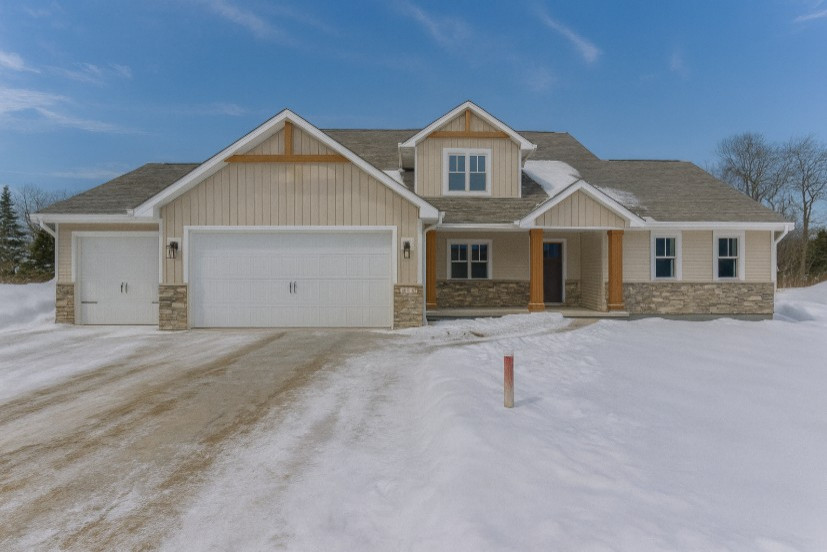Battling Alberta Winters: The Best Materials for your home

Battling Alberta Winters: Best Materials for Homes in Lethbridge & Southern Alberta
Building for Prairie Winters: Why Material Choice Matters
Southern Alberta's climate is famously unpredictable. Heavy snowfalls, hail, icy winds, but then the next day a warm chinook blows through. These freeze-thaw cycles can occur within days. For homeowners in Lethbridge, selecting durable and energy efficient building products is more than an aesthetic choice, it directly impacts comfort, resilience and long term costs. Thoughtful material choices will help your home shrug off blizzards, reduce heating bills and maintain it beauty for decades.
Exterior Walls & Siding
Fiber-Cement Siding
Why It Works:
Fiber-cement products such as James Hardies line can be engineered for cold climates. Fiber-cement resists shrinking, cracking and freezing in Southern Alberta's freeze-thaw cycles and are highly resistant to moisture, fire and pests. Because fiber-cement is non-porous, it also resists mold and mildew and can be painted to refresh its look.
Engineered Wood Siding
Engineered wood offers the warmth of natural wood but with stabilizing treatments that reduce warping and cracking in cold weather. It provides a handsome prairie aesthetic without the maintenance of solid wood.
Stone or Brick Veneer
Thin stone or brick veneer adds classic Alberta charm and some may even add extra insulation value. The added mass helps buffer your home from temperature swings and provides exceptional durability.
Tip: You will want to avoid using low cost vinyl siding. Vinyl becomes very brittle and prone to cracking in extreme cold. Vinyl siding can also expand or contract as much as 3/8".
Windows & Doors
Triple-Pane Windows & Low E Glass
Triple-pane windows include three panes of glass with two sealed gas cavities and Low-E coatings. They provide far better insulating value (R-value), reduce outside noise and improve condensation resistance. In Canadian winters, triple-pane units are considered the gold standard. Inert gas fills and warm-edge spacers further reduce heat transfer, and the Low-E coatings reflect interior heat back into your home while still letting in visible light.
Insulated Steel of Fiberglass Doors
Modern steel or fiberglass exterior doors come with insulated cores that stand up better to drafts and temperature swings than traditional wood doors. Combined with quality weather stripping, they keep cold air out and help your furnace work less.
Roofing Materials
Architectural Asphalt Shingles
Laminated/ architectural shingles with high wind ratings offer cost-effective protection when installed correctly and should be considered a must have for homes in and around Lethbridge. Proper nailing patterns, starter strips and ice & water shield membranes are vital to resist uplift and leaks.
Metal Roofing
Metal roofs offer the highest durability, they shed snow easily, withstand high winds and hail. They last decades with minimal maintenance.
Ice & Water Shield Underlayment
An Ice and Water shield is an adhesive membrane installed under shingles around eaves and in valleys. It prevents water from penetrating when ice dams form, protecting your roof sheathing.
Framing and Insulation
Engineered Lumber
Engineered lumber products, such as LVL beams and I-joists,
are designed to maintain their dimensions well. They are less prone to warping, shrinking, or cracking compared to traditional lumber, making them ideal for the wild temperature swings that we all are familiar with here in Lethbridge.
Spray Foam & Rigid Foam Insulation
Closed-cell spray polyurethane foam (SPF) provides an
R-value of approximately 6-7 per inch and serves as both insulation and an air
barrier. Rigid foam boards (EPS, XPS, polyiso) offer R-values ranging from
3.6-6.5 per inch and are excellent for use in exterior sheathing or basement
walls. By minimizing thermal bridges, both solutions help retain warmth indoors
and reduce heating expenses.
Foundations & Basements
Insulated Concrete Forms (ICF)
Insulated concrete forms establish a continuous air
barrier, high thermal mass, and a substantial R-value, reducing thermal
bridging and moisture infiltration. When combined with appropriate waterproof
membranes and drainage systems, ICF basements remain warmer, drier, and more
comfortable throughout the year.
Energy Efficient Systems
High Efficiency Furnace
Modern furnaces achieve an AFUE of 90-98.5%, wasting as little as 1.5-10% of their
fuel. Upgrading to a high-efficiency model can lead to a 15-45% reduction in
heating costs while enhancing indoor air quality through advanced filtration
systems that capture dust and allergens.
Heat Recovery Ventilators (HRVs)
In airtight homes, HRVs replace stale indoor air with fresh outdoor air
while recovering heat. They preheat incoming air in winter and pre-cool it in
summer, reducing energy usage and enhancing indoor air quality. HRVs are
especially beneficial in cold climates, as they remove excess humidity and
conserve thermal energy.
Radiant In-Floor Heating
Radiant
floor heating warms rooms from the ground up, offering greater efficiency
compared to baseboard or forced-air systems. Hydronic radiant floors use hot
water and minimal electricity, making them well-suited for climates like Southern Alberta, where
heating is a primary concern. Individuals with allergies often prefer radiant
heat due to its minimal circulation of dust and allergens.
Final Thoughts: Crafting a Winter Ready Home in Southern Alberta
Building or renovating homes in Lethbridge and its
neighboring areas demands materials and systems that can withstand the harsh
winters. By selecting durable exterior cladding, high-performance
windows, reliable roofing, robust insulation, efficient heating/ventilation systems,
homeowners can enjoy comfort year-round, lower utility bills, and peace of
mind.
Partnering with K2 Prairie Builders
At K2 Prairie Builders, we specialize in custom home builds, large‑scale renovations and additions tailored for Southern Alberta’s climate. Our team carefully selects materials that stand up to prairie winters and ensures craftsmanship that lasts. Whether you’re in Lethbridge, Coaldale, Taber, Coalhurst, Raymond, Magrath or Fort Macleod, we’re ready to bring your vision to life.
Contact us today to plan a home that’s both beautiful and winter‑tough.
